VOL.46, NO. 2
Kubrick’s Lolita: Quilty as the Author
Irena Księżopolska
Much has been written about Kubrick’s adaptation of Lolita. Most of the critics complain that Kubrick drastically simplified the tale (Crowther, Pfifer 305-321, Leitch 241-242, Burns 245, Kael 183-188), smoothing it into an almost “normal” love story, getting rid of almost all literary allusions and, most disappointingly, of the narrative complexity so crucial for Nabokov’s novel (Appel 229). After Adrian Lyne’s 1997 adaptation of Lolita was aired, some critics nostalgically turned back to Kubrick as the better, more subtle storyteller (Denby; Colapinto). Still, most seemed to agree that Nabokov’s novel was badly served by its cinematographic retellings.
Nabokov’s attitude to the film was far from simple. He was credited as the screenwriter, yet this was clearly an overstatement: judging by Nabokov’s published screenplay, very little of it survived in the film. In his introduction to the published screenplay Nabokov, is clearly critical, and yet, still careful to always stress that the film is “first-rate.”1 It is often the case with film adaptations that the collaboration between the writer of the novel and the director of the film is troubled, but in the case of Lolita the relationship between Kubrick, the highly original and self-conscious film auteur, and Nabokov, the absolute dictator in the textual realm, is a clash of two masterminds2 which has been compared by some to the struggle between Humbert and Quilty (Mazierska 29). Julia Trubikhina writes that “Kubrick’s film Lolita is a result of a palimpsestic process – Kubrick’s and Nabokov’s struggles for the control of the narrative in the course of writing the screenplay,” and she also cites Nabokov’s own acknowledgement that any adaptation is but “a collision of interpretations” (142, 148). This essay will examine the resulting texture, in order to delve into the intricacies of cinematic representation, giving its due to Kubrick’s famously obsessive attention to detail which may rival Nabokov’s own. As the analysis will show, Kubrick tries to out-Nabokov Nabokov in his deliberately staged, elaborately detailed, deviously sophisticated visual representation, though it takes a paranoid spectator to unravel the puzzle of the hazardously unreliable cinematic narrative. This essay will be precisely such a paranoid reading of Kubrick’s insane – though apparently mainstream – film, which will insist on viewing Quilty as the master of the text, at least in its reading by the film director.
Screenplay VS Film: the Murder Scene
Kubrick’s highly selective treatment of Nabokov’s screenplay may appear quite natural; although Nabokov worked hard to find visual equivalents for his complex verbal structures, quite often, in the words of Julia Trubikhina, not the actual scenes but rather his “film directions, mostly unstageable, take on a considerable part of the novel’s glee” (154). Nabokov’s script is structured according to the rules of the language shifted uneasily into the visual dimension, exorbitant in its demands on the viewer. For instance, when it describes the murder of Quilty, the scene is temporally brief but packed with meaningful imagery:
They face each other. Now begins a silent shadowy sequence which should not last more than one minute. As Humbert levels his weapon, Quilty retreats and majestically walks upstairs. Humbert fires. Once more. We see him missing: the impact of a bullet sets a rocking chair performing on the landing. Then he hits a picture (photograph of Duk-Duk ranch which Lolita had visited). Next, a large ugly vase is starred and smashed. Finally, on his fourth fire, he stops a grandfather clock in its clacking stride. The fifth bullet wounds Quilty, and the last one fells him on the upper landing. (Novels 678)
Everything is significant: the picture – the photograph that the viewer should understand the meaning of by the end of the film; the rocking chair which will reappear as a constant theme throughout the film; the ugly vase (metaphoric representation of Charlotte’s fate?) and the grandfather clock – clear, even a little heavy-handed symbol of death. But the entire scene of shooting would take only a few seconds and the viewer would not have the time to realize either significance, or the precise meaning of these objects. The viewer would be focused on whether or not the bullets hit the victim – someone being pursued and eventually killed for as yet unknown reason. The only way to appreciate the allusive wealth of the scene would be to study it in slow motion, or to review it still by still – that is, to read it precisely as one reads the sentences on the page.
It seems that Kubrick realized the problem and this caused his decision to restage the beginning. However, though Kubrick’s version is much longer, and far from silent, it is also crammed with details. It would appear at first glance that none of the objects populating the mise-en-scene carries any significance whatsoever. Quilty’s house is a mess, stuffed with strange sculptures and framed pictures, furniture wrapped in white sheets, empty bottles and glasses scattered throughout the lushly and tastelessly decorated space. A sculpture with a high-heeled shoe on its head, another with a sandwich impaled upon its mythical spear, a painting on its side next to the entrance, the ping-pong table, piano, the box with boxing gloves – all these objects seem completely incidental. In fact, it takes a careful analysis of stills of these scenes to even notice the abovementioned items.
Beginning the film with the scene of unexplained murder and looping back to it by the end of the film is, apparently, something Kubrick suggested to Nabokov early on:
I discussed this approach with Nabokov at the very outset, and he liked it. One of the basic problems with the book, and with the film even in its modified form, is that the main narrative interest boils down to the question, “Will Humbert get Lolita into bed?” And you find in the book that, despite the brilliant writing, the second half has a drop in narrative interest after he does. We wanted to avoid this problem in the film, and Nabokov and I agreed that if we had Humbert shoot Quilty without explanation at the beginning, then throughout the film the audience would wonder what Quilty was up to. Of course, you obviously sacrifice a great ending by opening with Quilty's murder, but I felt it served a worthwhile purpose. (Phillips 88)
In fact, Kubrick did not exactly sacrifice a great ending; he returned to the scene, asking the viewer to re-watch Humbert entering the mansion and calling for Quilty, without, however, repeating the farcical dialogues and the final shooting. From the image of Humbert calling Quilty’s name, we cut to the image of the painting with bullet holes (see Figures 1 and 2).
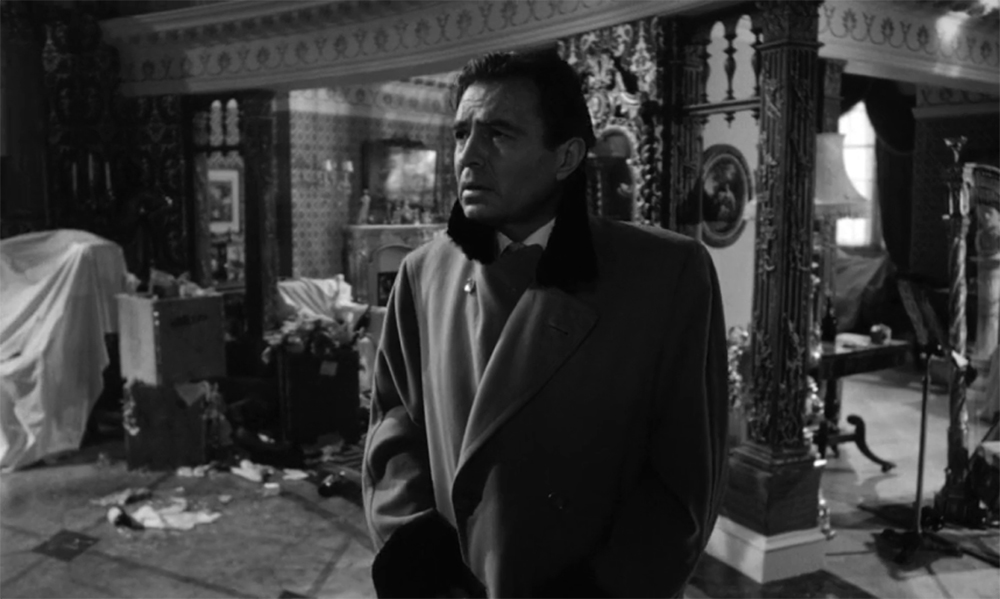
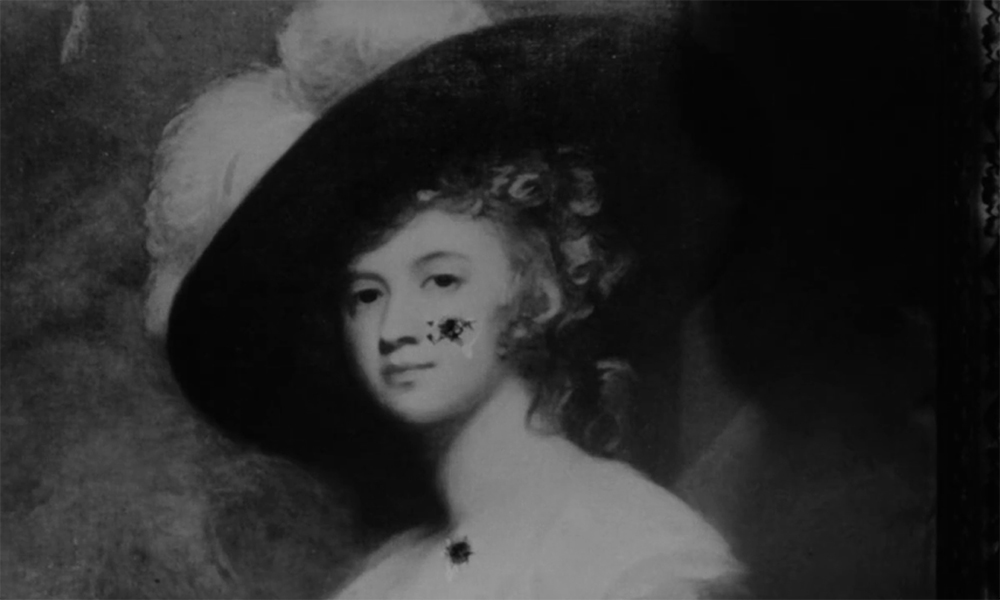
This ending seals the story – when the final image of the painting appears, the spectator comes away enriched by the knowledge of Humbert’s motivation and, po ssibly, with some satisfaction at the outcome: Quilty appeared a rather sinister character throughout the film and having Humbert finally overcome him is not entirely displeasing. As Lara Delage-Toriel notes, Kubrick has the viewers perform exactly what Quilty invites Humbert to do – attend and observe an execution. However, there is one minor detail that saves us from feeling the guilt of complicity: we are never allowed to see the body of the victim. The painting stands as a screen, confirming the death while denying us the conclusive evidence of eye-sight.
The way the opening sequence is shot is curiously incongruous. For instance, the first image that appears after the credits sequence is a car driving through an avenue of trees into the thick fog.3 The next shot, however, shows the same car driving up to a courtyard in broad sunshine, with its metal stripes gleaming. Quilty’s house appears as a typical Gothic mansion, and, yet, the camera work seems to belong to a different genre (see Figures 3 and 4).
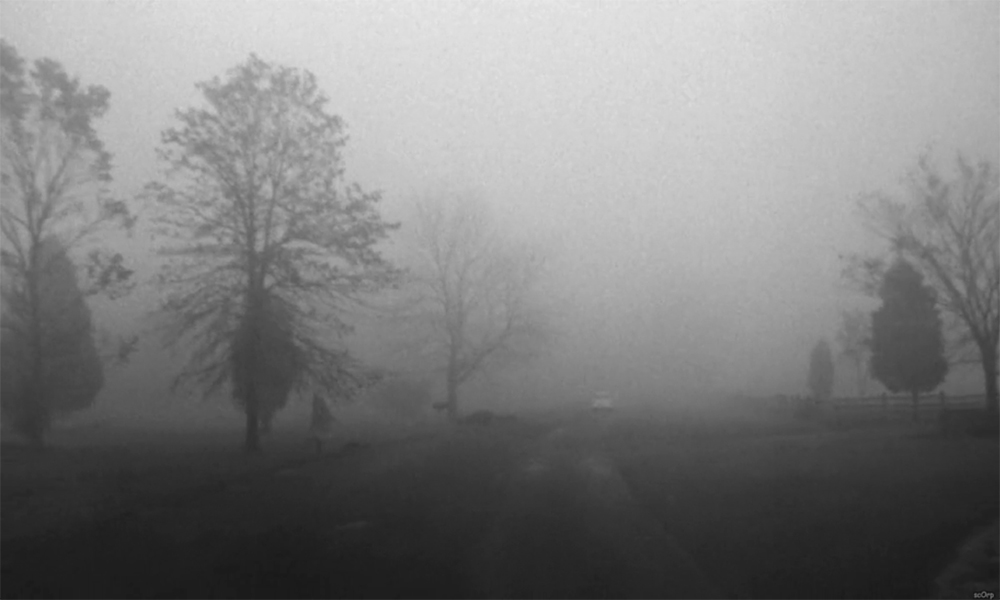
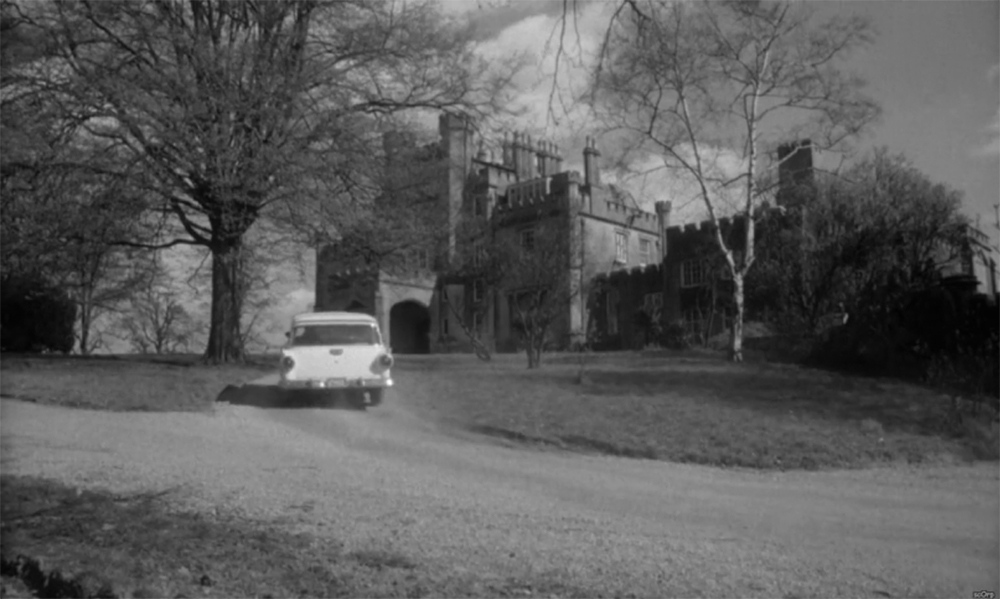
As Robert Stam pointed out,
Quilty’s Pavor mansion is the gothic castle par excellence, yet the lighting is not expressionist, as would be the norm in horror films, but rather high key. The scene is beautifully choreographed, and more importantly, reproduces the sense of a gap between style and content, since a very serious event – a murder – is treated in the tone of a blackhumored prank. (Stam 123)
In the novel, the scene of murder takes 12 pages and is described as a grotesque comedy – it seems scripted according to the rules of fairytales and cartoons in which characters, no matter what trouble befalls them, never quite die. At some point the reader may even suspect that the entire scene is a dream – for instance, when Humbert notes: “I may have lost contact with reality for a second or two (…) a kind of momentary shift occurred as if I were in the connubial bedroom and Charlotte were sick in bed. Quilty was a very sick man. I held one of his slippers instead of the pistol – I was sitting on the pistol” (Annotated Lolita 304). Humbert also gives us an intimation of how long it took him to finish off Quilty – well over an hour.
By reducing it to mere half a page of screenplay – and some two minutes screen time – Nabokov is deleting one of his most dreamlike sequences, “the most fantastic chapter in the novel” (Annotated Lolita 447), removing the absurdity of a drawn-out farce and instead producing the stately impression of the final act of a classical tragedy.4 As a result, in the script the antagonists acquire a certain dignity which they certainly did not possess in the novel. Quilty retreats “majestically”, Humbert advances like the shadowy killer in a noir film. Shots rent the silence, the objects are seen in a quick succession of shots.
While Kubrick kept the atmosphere of the noir for his film, deciding to shoot it in black-and-white and using some of the typical devices of noir cinema,5 for this crucial scene he disagreed with Nabokov’s staging choices. He resurrected the absurd comedy-murder of the novel,6 though not following it closely in terms of action and speech, but instead allowing Peter Sellers to improvise his own weirdness into the story.
The first weirdness is Quilty appearing out of nowhere – or, to be exact, from under the white sheet. The indication is that he is already a corpse, already a murdered man – a brilliant addition to Nabokov’s script. But there is a bottle perched on his head – and this is a curious touch. Either it means that one of his guests played a joke on him, by treating him as a piece of furniture, or, more interestingly and fittingly, he himself arranged his position, setting the scene for the most comic effect (see Figure 5).
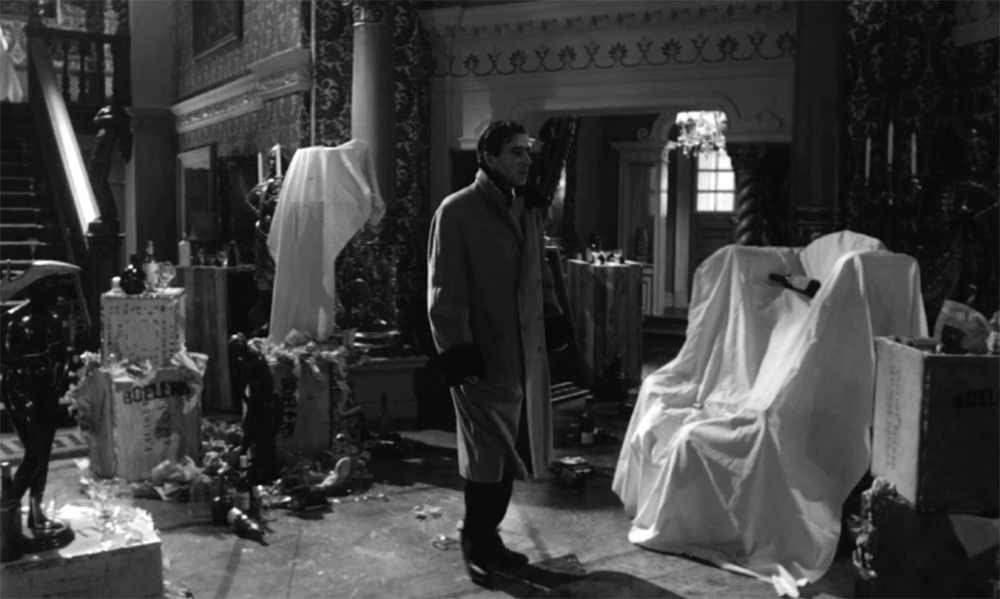
Next comes an exchange of words between the antagonists which most critics take for an intertextual reference:
H: Are you Quilty?
Q: No, I'm Spartacus. Have you come to free the slaves or something?
The reference is to Kubrick’s previous film, Spartacus (Leitch 242, Appel 245). A game of “macabre ping-pong,” apparently improvised by Peter Sellers (Appel 231), follows – an invention that Nabokov himself appreciated (Novels 676). “I'm really winning here. I'm really winning. I hope I don't get overcome with power” murmurs Quilty at one point. Clearly, the scene is all about the balance of power, and Quilty, though at a disadvantage (his home is invaded by a stranger, he has a severe hangover or worse), is somehow still in control. Humbert pulls out his gun, Quilty quips about a “bad looser” and wanders off in search of a drink. He is deliberately ignoring the danger, turning his back to the gun and thus forcing Humbert to delay execution. Quilty has his drink – with ashes in it, again a rather significant detail – and is next made to read Humbert’s poem. The poem, Nabokov’s parody of T. S. Eliot, was deleted from the screenplay as an over-literary element, but Kubrick restored it, allowing Quilty, once again, to play his own game with the text, this time introducing a phony southern accent – perhaps another reference to film medium, to Western genre in particular. His rendering of the verses, interjected with a running commentary, clearly ruins the moment for Humbert – it is not what he imagined it would be. Quilty seems to treat the appearance of Humbert as a kind of sick joke, not too amusing at that. It is not merely that he ignores the danger: while play-acting a severe hangover, he remains quite lucid and self-aware, as if Humbert was acting out something scripted, in an audition for a role. Next comes the scene with Quilty in boxing gloves – strikingly resembling the famous picture of Nabokov in the same pose, taken sometime in the sixties (see Figure 6).7
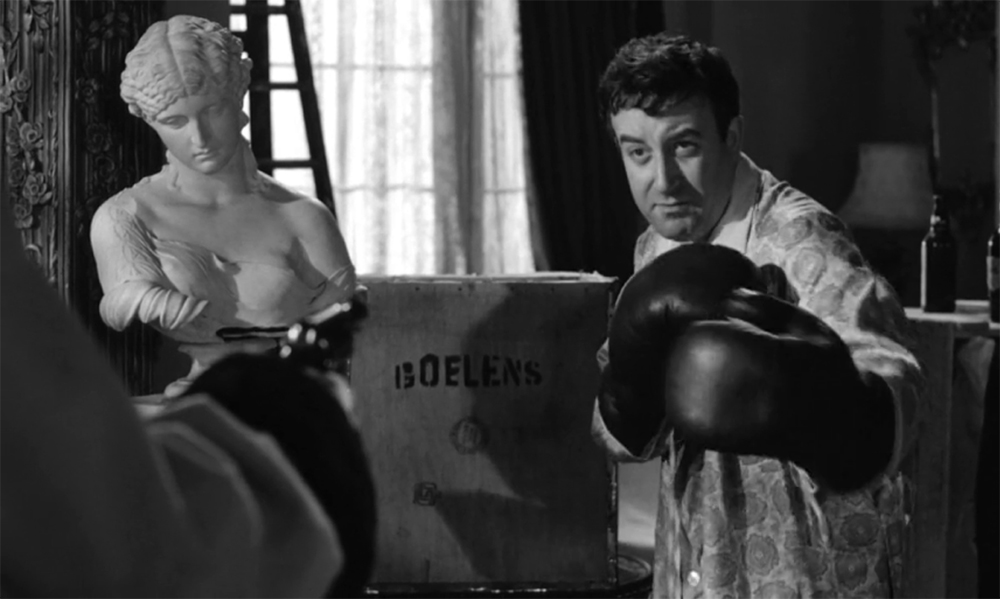
Humbert shoots, Quilty scrambles to the piano and plays a song from 1953 film The Moon is Blue in which two ageing gallants try to woo the same girl (“she’s mine tonight – yours – she’s yours tonight”). Then he finally begins acting out his fear and runs up the staircase – Humbert keeps shooting, missing most of the time, but finally managing to wound Quilty somewhere in the leg. Then Quilty relaxes for a moment, thinking the bullets are finished, and realizes that nothing is over when Humbert reloads. Quilty hides behind the painting, and the viewers hear the shots, see the holes appear on the painting and finally hear the heavy thud of the falling body.
The Painting
While this lasts, both Humbert and Quilty move among the orgy of visible objects, which are easily missed during the first watching. The objects seem to be there in order to construct the absurd side of the situation, a setting in which every movement sets something rocking or falling down and smashing into pieces. But some of the objects are clearly privileged – for instance, there is the painting behind which Quilty supposedly dies, the image that makes a backdrop for the credits at the end of the film. It is usually said to be painted in the manner of Gainsborough, but we were able to identify it as the portrait of Mrs. Bryan Cooke, by George Romney, painted about 1787-91 (see Figure 7).
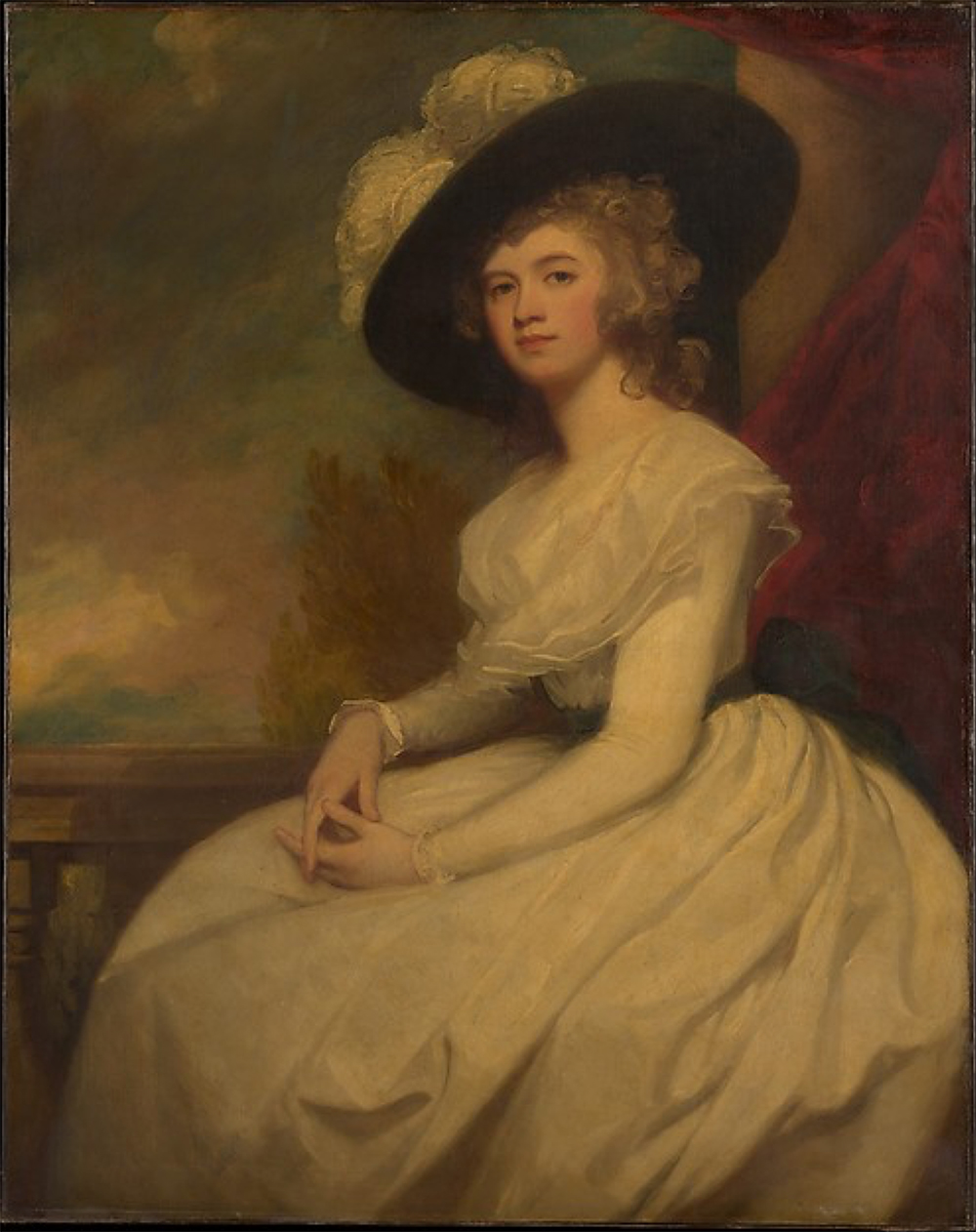
A youngish woman in eighteenth century dress and a large hat sits in half-profile, her arms forming a gentle loop, with fingers loosely crossed, in a semi-balletic pose. She is almost, but not quite, smiling, looking demurely at the spectator. She must be a stand-in for Lolita – Humbert shoots his prey through her image which is, of course, richly significant.8 But the only resemblance to Lolita is the hat which might have been noticed by the viewer when Lolita first appears on the screen, sun tanning and wearing a wide-brimmed white hat.
But the image is significant for another reason. In fact, when we see Humbert firing through the painting, we are seeing it already for the second time, although most likely without realizing this. The image already featured in the first interior shot of Quilty’s house (see Figure 8).
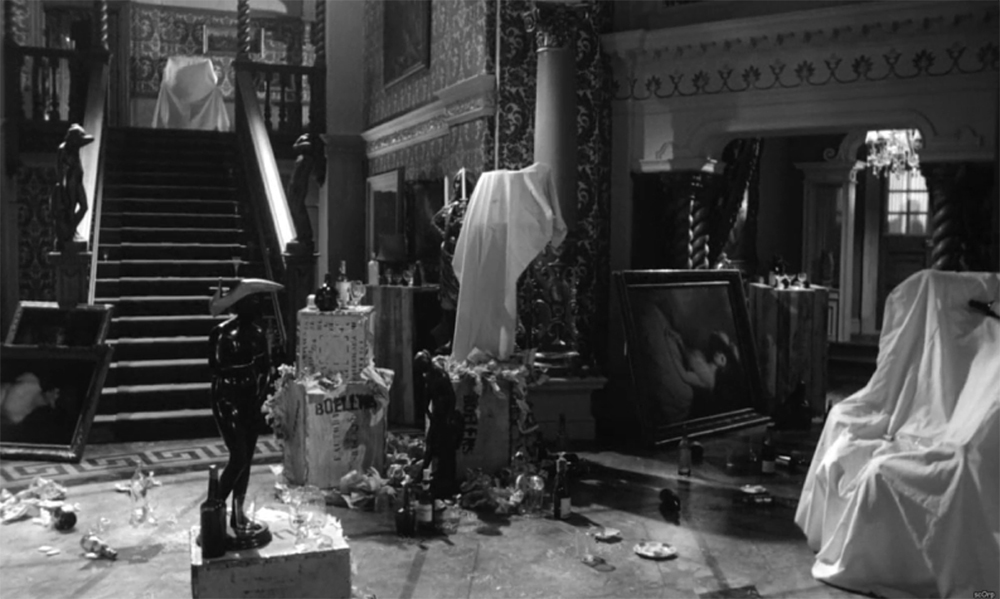
Yet, it is not where it should be – it is right by the entrance, and it is turned on its side. When Quilty will try to hide behind the picture, it will be upstairs, and standing upwards, with some other frames piled up around it. These will include the landscape which is shown hanging on the wall of the landing just a few moments earlier.
We might assume that there are simply two pictures – copies – used in this scene. This, of course, would work very neatly with the idea of the doubles which is being developed both in the novel and in the film. Quilty is Humbert’s double, or vice versa. He reproduces some of Humbert’s awful vices, and he is also a playwright, while Humbert is clearly a writer of some note (in the film his published books are the source of his wealth). But, as Julia Trubikhina writes, they are “doubles of a peculiar sort (…) If [Quilty] is Humbert’s reflection, he is a reflection in a concave or convex mirror” (167).
There is also another interpretative possibility: Lara Delage-Toriel also notices the painting in the hall and comments that “the double occurrence of the painting would (…) seem to betray its bogus nature, its mere function as a prop on an eminently theatrical stage.” But this does not solve the problem. If we look carefully at the opening shot, we can see the staircase quite clearly. There are no paintings on the landing, only another armchair covered by a white cloth. Through the bars of the railings we see that the landing is almost empty. This is confirmed in the following shots, when Quilty is shown clambering up the stairway and being wounded by Humbert (however, the white-covered armchair disappears). Then, the camera turns to show Humbert reloading, and when it switches back to Quilty, we already are looking at the side shot from the landing, and we see it quite clattered with various objects, the painting of Mrs. Bryan Cooke among them (see Figures 9, 10, 11).
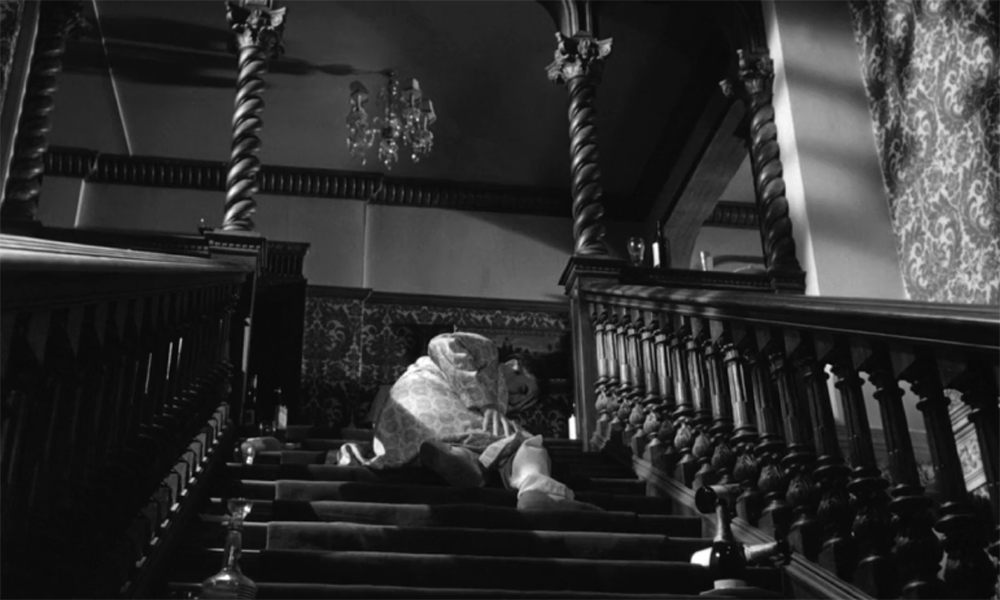
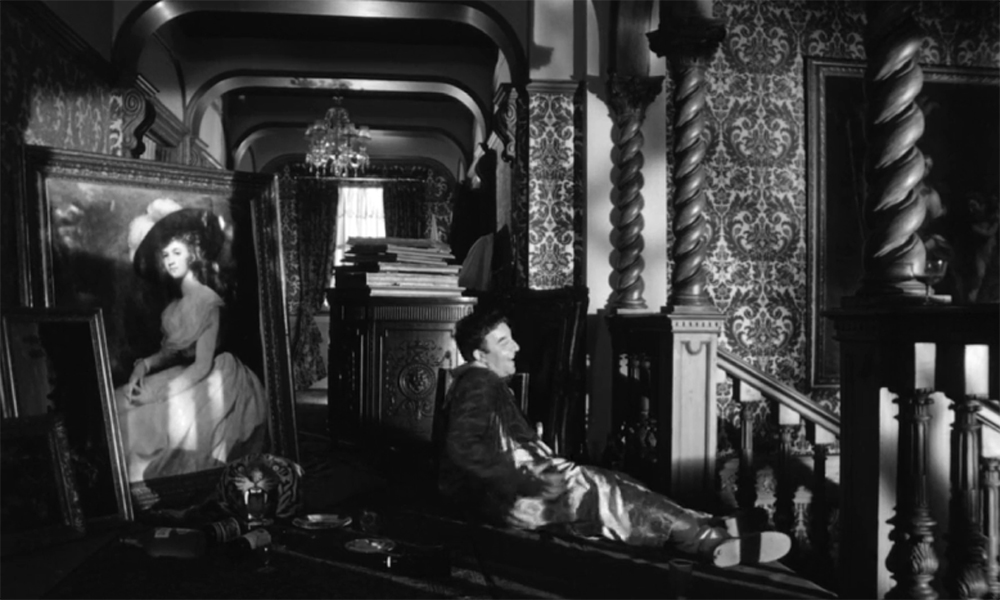
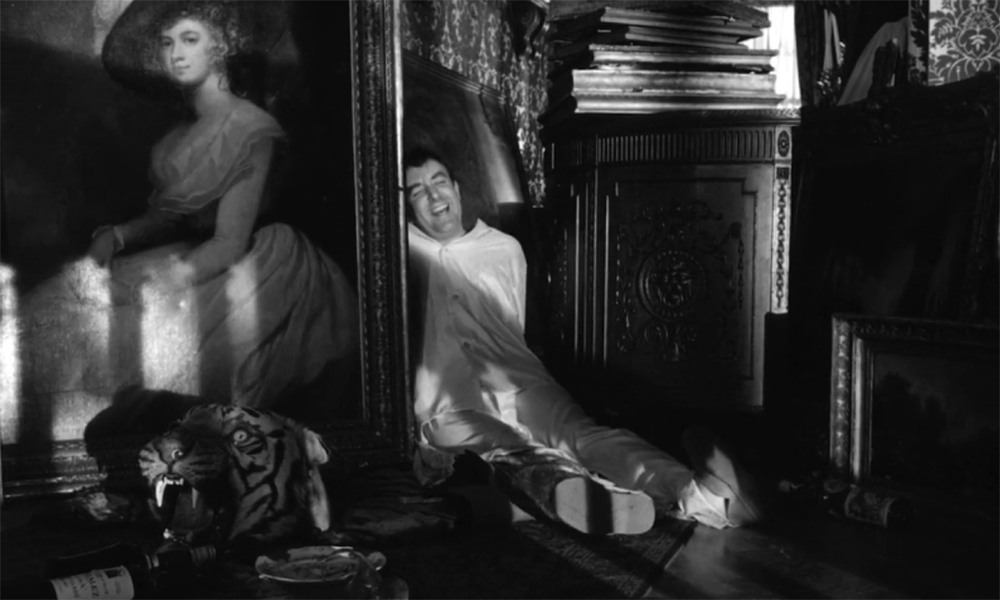
If we look closely at this image we see that its arrangement is far from incidental. The girl’s demure pose in the painting contrasts with Quilty’s anguished but still clownish scowl. Perhaps as a sign of Lolita’s imprisonment within the mad art of Humbert’s prose, there are the shadows of the bars falling on the picture – a typical iconography of the noir genre. There is also a surprising tiger with open jaws – another predator’s scowl made harmless by death. In Nabokov’s novel no tiger skin decorates Quilty’s rooms, but there is a polar bear skin, which reinforces the theme of the double: Humbert has been on a polar expedition, and Quilty seems to keep a memento from that trip. But since no mention of Humbert’s polar adventure is made in Kubrick’s film, the bear skin is replaced by a more Blakean reference – ferocious tiger next to the image of white-clad Lambic innocence in the painting, with the bottle and the ashtray in the foreground constituting yet another frame of bohemian depravity.
But to return to the portrait: there is absolutely no logical explanation of how this painting travelled up the stairway so quickly, together with the other objects. It feels correct to consider it as a prop, but we must admit that it is not “just one more element in the decor; a redundant object at that, since it isn't a unique work of art” (Delage-Toriel). The sudden appearance of objects out of nowhere is a signal that we are not just watching a farcical situation of Humbert’s real life, but a staged version of it – most likely, the play that Humbert mentions in the novel at the very beginning, when he reads the short bio of Quilty in the Who’s Who in the Limelight, and offers an addition: “The Murdered Playwright,” darkly hinting at the as yet undescribed murder. Who is the author of this play? From Humbert’s narrative it would appear that he is its active force: he is the one who corrupts Lolita, he is the one to finally track down Quilty and carry out his “death sentence.” Most importantly, he is the one who apparently survives the first (and last) scene. But, even in the novel, when he exits Quilty’s house at last, a strange reversal seems to take place: “This, I said to myself, was the end of the ingenious play staged for me by Quilty” (Annotated Lolita 305).
Is he, then, admitting to have played a part in a production staged by another? Is he asserting that this is where the theatricals must end, because a character murdered his author?
In Nabokov’s novel this remains a tantalizing possibility. In Kubrick’s film, we would argue, it is far more than that, it is an overriding framework, the only way to understand the curious manner in which Quilty is constantly present throughout the film, which begins and ends with Quilty’s name (unlike the novel, which begins and ends with the word Lolita).
Quilty and the Narrative Framework
Stephen Schiff, the scriptwriter for Lyne’s film, commented in his interview: “Kubrick (…) made a film that might better have been titled Quilty. Very much in the thrall of Peter Sellers, he allowed Quilty to take over the movie, with Sellers improvising vast swatches of dialogue” (Stringer-Hye). He clearly believes that Sellers “stole” the film by his weird improvisations, an opinion which is shared by Alfred Appel (231-232). Yet, while it is undeniable that Sellers had extraordinary freedom to bring his character to life, we could argue that even this particular privilege shows that Kubrick’s plan very consciously made Quilty the main hero in the story. While still working on the film casting, Kubrick wrote: “Quilty will be a mysterious presence. (...) Every time we catch a glimpse of Quilty we can imagine anything, police, pervert or parent” (Abrams 21).10 Robert Stam noted that he was already quite important in the text, and that his more substantial appearance on screen suited Nabokov’s style well:
The Quilty character becomes a shape-shifter, incarnating some of the protean, Menippean spirit that animates the novel. (…) Through a kind of displacement from narrative to character, Quilty becomes something of an ambulatory intertext, a performative embodiment of the Nabokovian style, no longer as literary citation but rather as allusive improvisation. (119-120)
Appel also indicated that though Quilty’s identity in the novel is hidden almost until the end, references to Quilty are scattered all through the text, providing a long (4-line) list of page numbers on which his presence is somehow felt (Annotated Lolita 349). In the film, Quilty seems to be the controlling presence which shapes each of the story vignettes. He is present in 16 out of 35 narrative units (Falsetto 10). His appearance always has a sinister shade of “visits of inspection” – he has the knowing, mocking, intrusively curious gaze of the superior intelligence (see Figures 12, 13, 14).

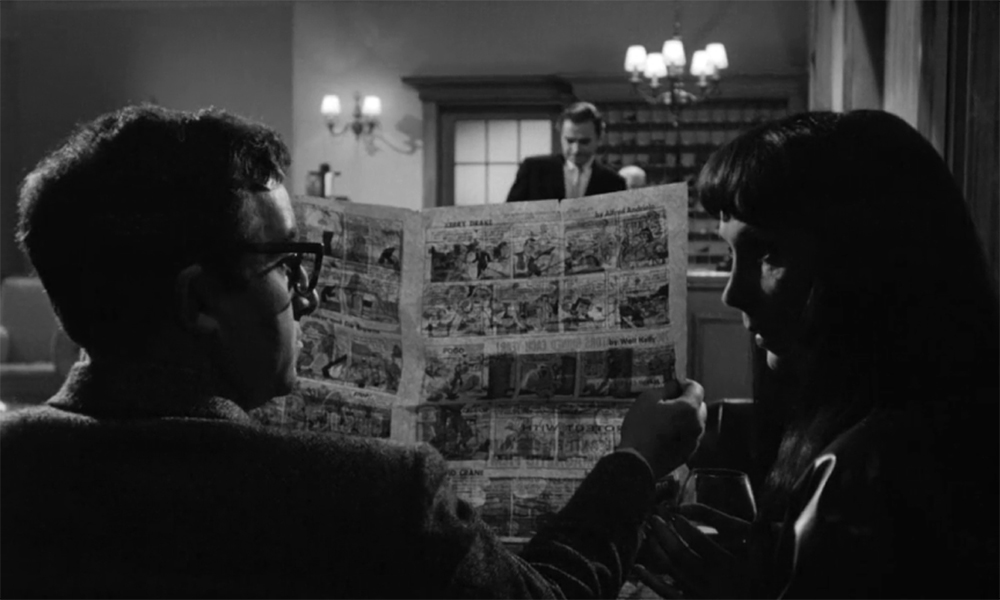
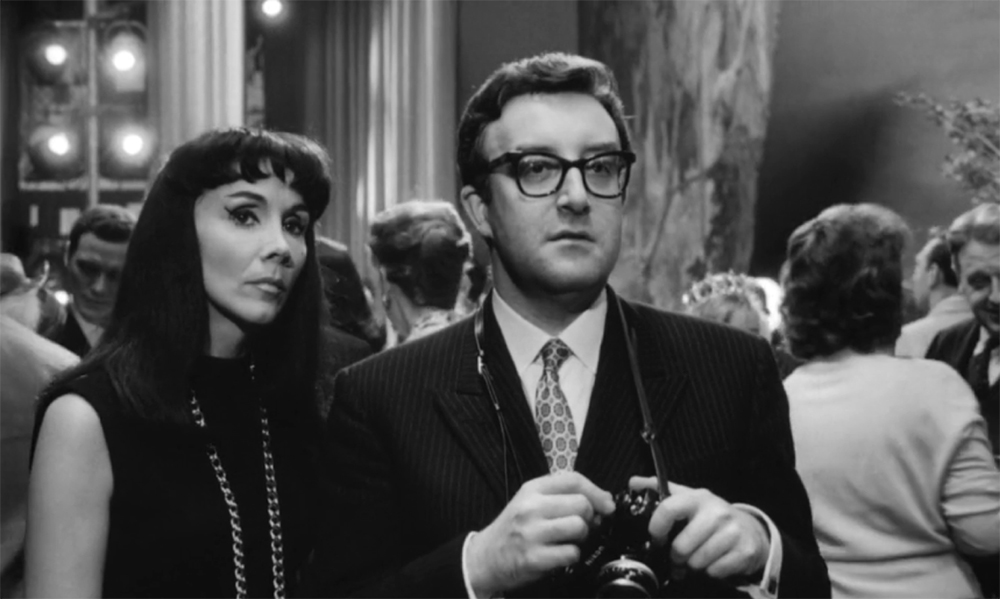
He also does not really belong to the seemingly simple narrative framing to which Kubrick resorted instead of the more complex structure of Nabokov’s screenplay, where Humbert’s narrative is embedded within John Ray Jr.’s. Kubrick seems to present Humbert’s narrative perspective straight from the start: the farcical murder is followed by a voice-over by Humbert which appears to establish the first narrative frame. The film continues, however, without ever attempting to be consistent with this framing, as some of the scenes are clearly out of the scope of Humbert’s perception, even though the voice-over technique is used again in the scene of the “failed murder attempt” (Humbert walking with the gun towards the bathroom where he believes Charlotte to be relaxing at the moment) and in 3 other scenes. The odd, out-of-the-frame episodes, however, are much more frequent than such reminders of Humbert’s narrative role. For instance, this refers to Charlotte crying after her futile attempt to seduce Humbert, or Charlotte talking to Lolita after the school dance, while Humbert is away making sandwiches (see Figure 15).
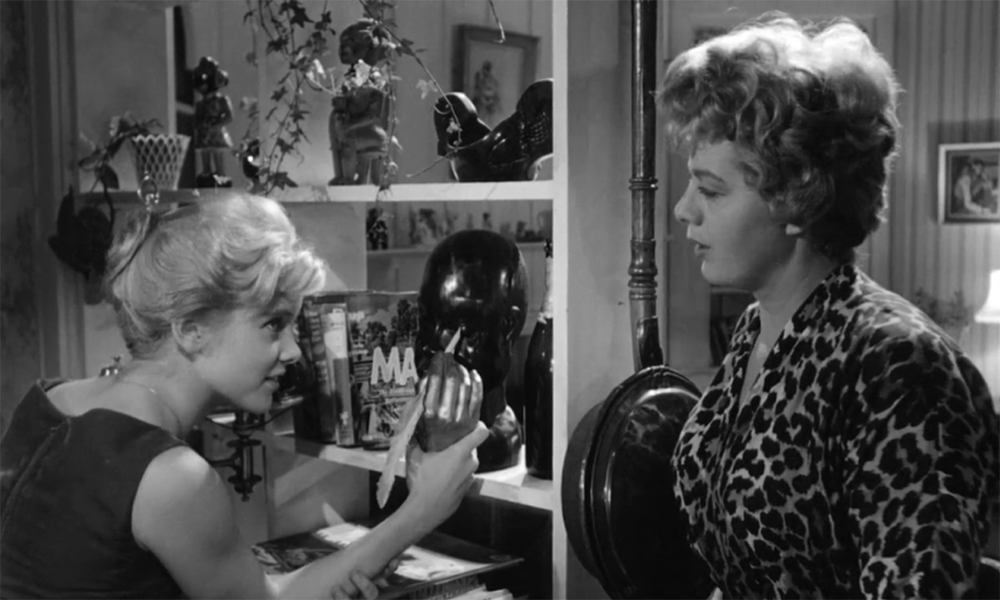
But most of these scenes with a range of perception other than Humbert’s concern Quilty: the dance at the school, the scenes at the Enchanted Hunters, at the school play. In all of these appearances Quilty’s presence is conspicuous to the spectator, but not to the hero.
These appearances are oddly unnerving – and not because of the comic genius of Peter Sellers, who remains mostly silent in many of these episodes. They decidedly suggest that the two characters – Quilty and his aide, mutely alert Vivian Darkbloom – are amusedly watching Humbert fall from grace, as if the net in which he was entangling himself was of their own making.
These appearances are oddly unnerving – and not because of the comic genius of Peter Sellers, who remains mostly silent in many of these episodes. They decidedly suggest that the two characters – Quilty and his aide, mutely alert Vivian Darkbloom – are amusedly watching Humbert fall from grace, as if the net in which he was entangling himself was of their own making.
Humbert remains oblivious of their presence until the very end, and, even when Lolita tries to connect the dots for him, he seems bewildered. We may try to explain this by stating that the story is told in retrospect, from the point in time where Humbert is mortally obsessed with Quilty, and he, therefore, restructures his past re-inserting Quilty’s presence into all the episodes where he believes to have been shadowed by his alter-ego. But this solution works only in part, firstly, because in many scenes Quilty’s presence is not incarnate, but rather vaguely hinted, as in the scene in which Lolita plays with an odd knick-knack of a hand holding a quill. The reference of the object is too subtle, too authorial (a hand holding another hand holding a quill), to be assigned to Humbert. Moreover, Mario Falsetto notes that in the film the spectators become “most aware of [this] character when he is not there. Lolita’s narrative construction depends on the ways in which this presence is alluded to throughout the film” (10-11). And this, clearly, is more than the effect of Humbert’s obsession, but rather an indication of a greater role played by this supposedly secondary character.
The most important reason why Humbert’s narrative authority is undermined is pointed out by Mario Falsetto. Since the first sequence of the film – the murder – is followed by the inscription “four year earlier” and simultaneous voice-over by Humbert, the entire following story is usually understood as Humbert’s flashback. But “a final end credit informs the audience that Humbert died in jail awaiting trial for the murder of Quilty, making the film not only one long flashback but apparently the flashback of a dead man” (Falsetto 86). Thus, if spectators are to believe what they see, Humbert is at least as dead as Quilty when the narrative begins.
Camera work persistently takes preference to a point of view other than Humbert’s. Quite often, in fact, the viewer’s angle of vision in these scenes coincides with that of Quilty. And in the odd conversation on the porch of the hotel, the way Quilty’s face remains unseen to Humbert while the spectators can observe it with some intimacy also suggests that the spectators are located on the same level as Quilty, who is playing with Humbert like a cat with a mouse.
Quilty in the film is not quite the same as either Quilty in the novel or in the screenplay. But, as Appel writes, “Kubrick is at his best, and nearest to the spirit of Nabokov (…), when he is able to blend farce and terror. Peter Sellers accomplishes this brilliantly in the role of Quilty. Whenever Sellers is on the screen, the film is ‘Nabokovian’ in its own right” (239). It follows that Quilty is easily identified as the most ‘Nabokovian’ narrative agent. Can we then suppose that Quilty plays the authorial role in the film? He is definitely in control in most of the scenes, but what about the ending / beginning? Can he be staging his own death?
The Letter
There is one quite interesting episode which also does not fit with Humbert’s angle of vision and which is scripted differently both in Nabokov’s screenplay and in the novel. It concerns the letter from Lolita, or rather Mrs. Richard F. Schiller. In the screenplay Humbert picks up the letter, and when he opens it during a college exam, Lolita’s voice reads its contents for the viewer’s and Humbert’s benefit (Novels 822). In the novel, the situation is almost the same – distracted by the janitor’s talk, Humbert opens the letter without noticing the handwriting and it begins “talking to [him] in a small matter-of-fact voice” (Annotated Lolita 266). But in the film Kubrick does not use the voice-over device at all, – instead, we see the letter in the process of being typed out, quickly, skilfully, clearly by someone who knows well how to use a typewriter. The soundtrack reproduces the typing sound alone. There is no indication of the location where this letter is being typed (see Figure 16).
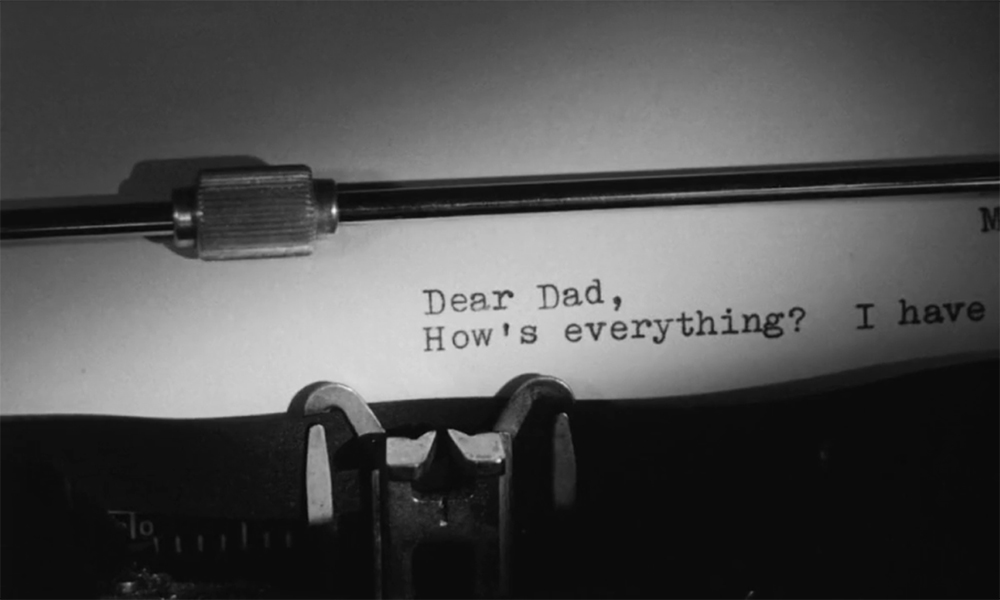
Those viewers who have read the novel automatically assume that it is Lolita writing to her stepfather. But why would Lolita use a typewriter? She does not seem to have one in her house, and she is not working as a secretary, but as a waitress. There is, however, another candidate who uses typewriter in his daily work, and that is the celebrated writer, Mr. Clare Quilty. Could it be possible that we are witnessing a scene in the play being typed up, in clean copy, to be passed on to the actors? This tempting interpretation is, however, unsatisfactory: there is no material to be acted in the letter, it is merely a summary of an unfilmed fragment of the story. Another possibility is that we see Quilty writing an invitation to Humbert to come and finish the game. This is the piece of paper which will eventually bring Humbert to Quilty’s house and conclude the film. A most ingenious ending: the death of the author.
The Death of the Playwright: Narrative Structure
What, then, of Quilty’s death? We have so many indicators of it being merely a playacting that we hardly need to answer this question. We do hear him die, but we never actually see it. And even the location of his death – the painting – is obviously a fake, not only because there is a copy of it downstairs, or because it magically appears on the previously empty landing, but because it only resembles itself. If we look closely at the original painting and the one that appears in the film we may notice small but telling differences. We are not looking at the genuine work of art, but at a representation which is supposed to only fool us. In the same way, we are not really watching the death of the author, but merely its representation, cunningly screened from us, ending the story in the most ingenious way possible.
Moreover, comparing the two scenes which begin and end the narrative, Lara Delage-Toriel spots many differences between the takes. She indicates that not only the arrangement of the details – too plentiful, too elaborate details – varies between the scenes, but also the way in which Humbert moves through the space, touches objects. Even the soundtrack does not repeat the initial scene (Delage-Toriel).11 This may be taken to mean that we are not watching the same scene twice, but two somewhat similar scenes, arranged in such a way that only a very careful observer would spot the discrepancies. This is a typical feature in the construction of puzzles or labyrinthine structures: the maker produces an illusion of repetition, thus suggesting that the puzzle solver or labyrinth walker is moving in a circle, while, in fact, distinctions exist between the two pieces / locations. If this is the effect Kubrick is after, he is creating in the film medium his very own structure which yet reproduces the sophistication of Nabokov’s method. Let us therefore suppose that the first murder scene and the scene that closes the film are different, and attempt to find an explanation of this arrangement, an exit from the labyrinth.
Let us return to the deceptively simple narrative frames used in the film. The first frame is the scene of nail-painting with both actors kept anonymous: we see merely the disembodied feet floating in the air and no less disembodied hands dutifully performing the pedicure. These frames might be easily discounted by the viewer as irrelevant, simply ornamental, since they are used as the backdrop for the credits of the filmmakers and actors. However, their appearance is, according to Jenkins, one of the Kubrick’s style markers: “a heavily visual sequence that immediately and purposefully seizes our attention (…) no words are spoken, but the images, the movements, speak for themselves, and the film’s guiding percept of obsessive love is promptly and convincingly set” (Jenkins 150). Why did Kubrick begin his narrative with this scene? Appel provides the answer: it is “a direct allusion to the same ritual of enslavement as managed by Fritz Lang in Scarlet Street” (228).
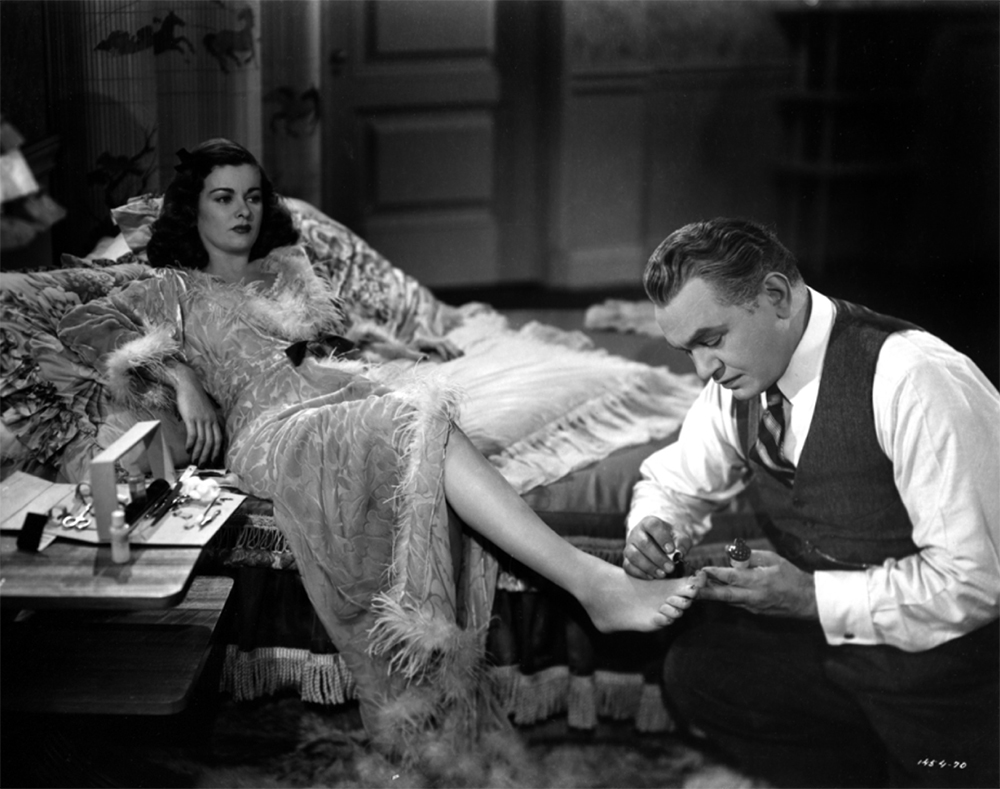
Appel treats this as a both an homage to tradition and a signal of Kubrick’s departure from Hollywood aesthetics, Kubrick' attempt to redefine the genre, producing his own “definitive film noir.” Scarlet Street indeed has a scene in which the protagonist (an artist) paints the toenails of his mistress, who is shamelessly using him – talent enslaved by lust. It also contains a murder of that mistress by the protagonist. Therefore, when Kubrick is invoking Scarlet Street he is building his very own equivalent to Nabokov’s Carmencitta theme: he is misleading the viewer to expect the murder of Lolita. Note that the scene that follows, with Humbert taking revenge on Quilty, does not contradict this notion: it is still absolutely possible that Humbert would be destroying Quilty after having killed Lolita.
The next frame is the murder episode, which culminates in the image of the painting with the bullet holes in it. It is succeeded by the third frame, with an image of a plane flying, a voice-over and the text across the screen “four years earlier.” This is now clearly marked as Humbert’s narrative, without, however, consistency in the focalization (as discussed above). Within this frame, there is a return to the first shot – the pedicure scene, now with the actors visible. In the context of the overall narrative, once again, it seems hardly relevant – merely an instance which demonstrates the intimacy between the protagonists. As Corliss writes, “he is the slave, painting her toes; she is the slave, acceding to his whim” (67).
It may seem that the first take differs from the second only in deletion of its characters. However, if we compare the two scenes, once again we will spot some very important though subtly played differences. Scene one (see Figure 18):
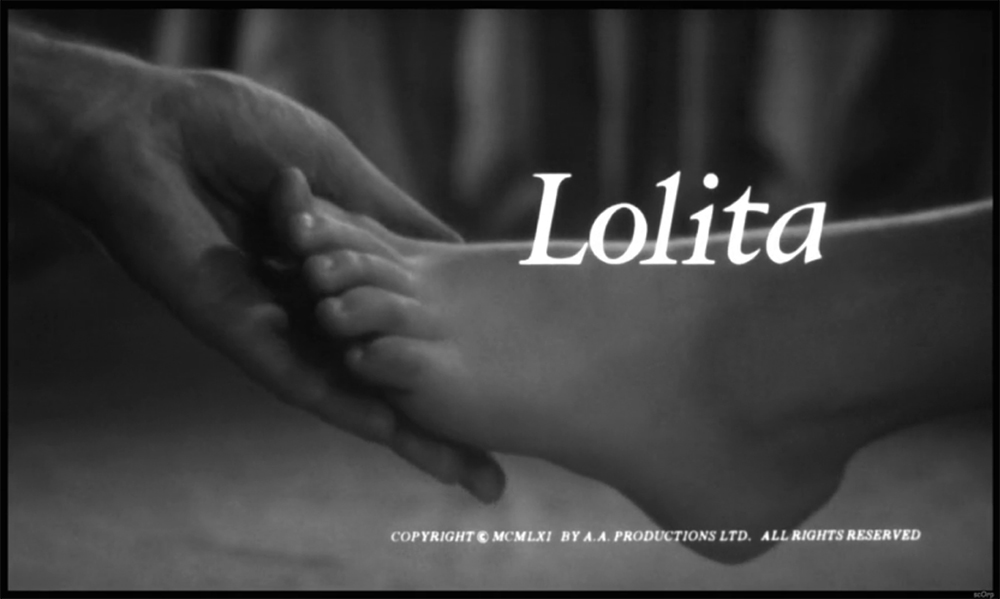
Fade in to a cluster of satiny drapes resting on a flat surface. The opening credits are fanfared by the swelling arpeggios of Nelson Riddle’s theme music. The words ‘James B. Harris and Stanley Kubrick’s’ disappear from the screen, and just before the word ‘Lolita’ appears a girl’s left foot drops into the frame, from top right. From the left of the screen a man’s left hand cradles the foot and applies nail polish to each nail, occasionally placing cotton wads between the toes. (…) At no time does the foot touch the bed; in a cramp-defying aerial act, it rests in the man’s hand. The toes are dutiful, disciplined, rising only when the cotton is applied; only once do they wriggle, just to let you know there is life in them. (Corliss 66)
Neither soft lighting, nor dreamy background with gentle movements reappears in the second take. It is rather sordid, with typically noir lighting (the horizontal blinds frequently used in the genre to indicate imprisonment). There is no “cluster of satiny drapes.” In fact, this is simply a different scene (see Figures 19 and 20).
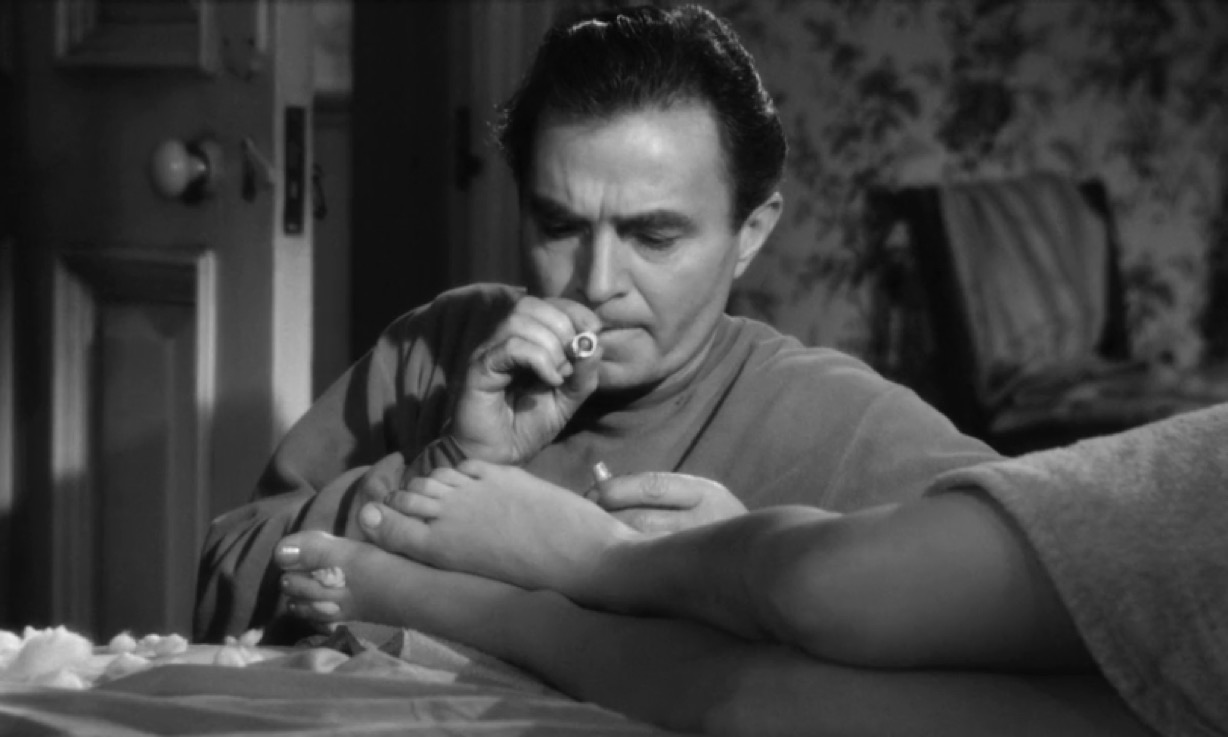
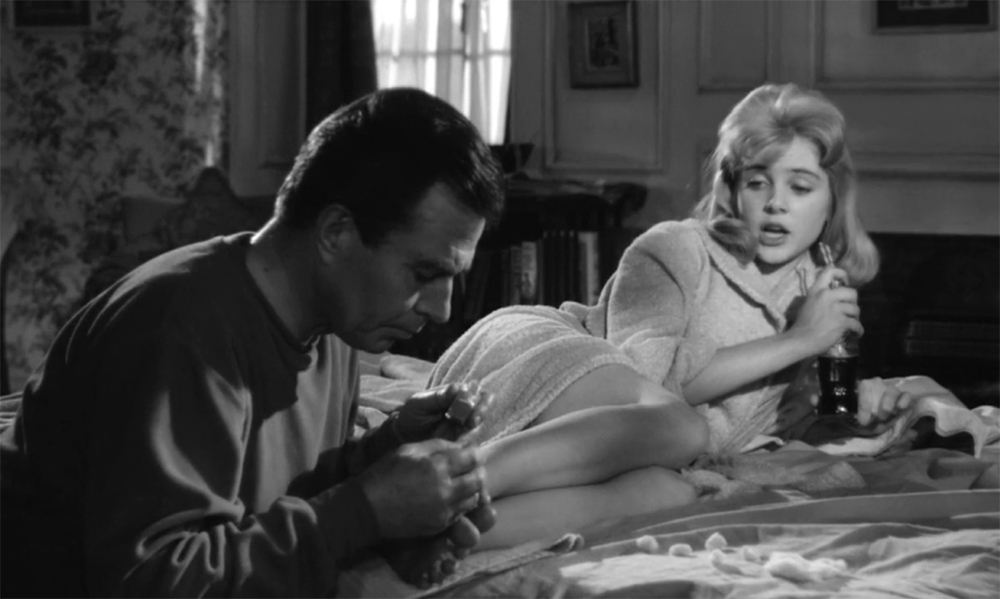
But this time what is happening seems easier to explain: the first take is a fantasy, in which everything is glossy and glamorous, the second – the reality, with the sharpened focus and complications which participation of the actual human beings always brings to any dream. And, importantly, in the first take, because not only the girl in the picture is generalized out of existence, but also the man grooming her feet is kept anonymous, this may indicate that it is not only Humbert’s dream. It may very well belong to Quilty as well.
Thus, first we get an idealized image, next Humbert’s unglamorous realization of it. The mechanism at work in this structure may be very similar to the one applied in the repetition of the murder sequence. First, we see the scene as planned, in the end – as played. We may remember here that Quilty is a screenplay writer, and that he enjoys filming risqué “art” projects. Usually, it is assumed that this means he simply deals in pornography (and Lolita’s words confirm this), but would it not be much more disturbing and perverse to have a different kind of film made: not a pornographic gloss, but a film in which a real person is embedded as an unwitting actor. That is, arrangements are made to have him achieve his secret dream, manipulated to become a monster, without realizing that he is a plaything in someone else’s intrigue – an enchanted hunter indeed. Harris, Kubrick’s partner in production of the film, says in an interview: “we wanted [Humbert] to be the only innocent person in the piece” (Corliss 32). And though Mason’s Humbert is wicked – in his desires and actions – he is innocent as well, if these acts are the result of a wicked script by another, superior villain.
Perhaps, then, it is possible to view the first murder sequence as something Quilty scripts – a plan of the way his great work of perversity should end. The last scene would then be its actual realization, with everything set to make Humbert into the murderer he was so unwilling to become (witness his botched attempt to do away with Charlotte). After Humbert appears on the carefully set stage, the narrative abruptly stops and drops the final curtain – the image of the shot-through painting. Humbert is not even seen committing the murder – viewers do the necessary work by assuming what really happened between the two takes, becoming, in fact, Quilty’s executioners. The mangled painting appears with the text over it: “Humbert died in prison for the murder of Quilty.” Who speaks? Let us note that nothing is said about Lolita’s fate – a curious, and meaningful omission, and a significant distortion of the story as it appears in the novel. The narrator of that last sentence which closes the film must be the mysterious “undead” screenwriter – the protean, incredible Mr. Clare Quilty.
To support this hypothesis, we may cite those critics who comment on the problematic nature of narration in the film. Falsetto, for instance, notes: “there is very little evidence that the film represents the subjective presentation of its main character. In fact, the major narrative and visual structures point insistently to an objective presentation. The ironic distance between Humbert's view of the world and the presentation of narrative information is what gives the film much of its resonance and pleasure” (86). If the narration is conducted from the point of view of Quilty – not as a character, but as the author of the script – the objective presentation becomes simply a feature of higher awareness of the narrator, and the ironic distance – a part of Quilty’s game, a feature of his style. Humbert is not only imprisoned in his passion for Lolita, or his obsession with his past (of which Lolita may or may not be a repetition12), or his paedophilia – he is also captured within the frame of Quilty’s story, intuiting his entrapment but unable to understand its nature.
Another curious twist this reading would introduce is that, if Quilty is the real narrator, Kubrick’s film fits even better into the framework of noir cinema. As Apple notes, “many films noir are also narrated by dead or dying men (…), a narrative device which undercuts the old-fashioned idea of “story” by revealing its outcome. What remains is the unfolding of a terrible, fated action, the fleshing in of the outlines of human pain and panic” (222-223). Quilty is the dead man who speaks – using the voice of another. The ultimate twist would be to hide this elegant solution by simulating simplicity of romance only bracketed by murder mystery. Kubrick’s Quilty indeed is the most Nabokovian hero who retains control by playing dead.13
Notes
1 As Ewa Mazierska writes, “Nabokov’s comments about the film give the impression that he was unhappy with the movie, but felt prevented from expressing his views” (25).
2 Nabokov in the Foreword to the screenplay famously writes: “I would have advocated and applied a system of total tyranny, directing the play or the picture myself, choosing settings and costumes, terrorising the actors, mingling with them in the bit part of a guest, or ghost, prompting them, and, in a word, pervading the entire show with the will and art of one individual” (Novels 673). Corliss, quoting Nabokov’s statement, comments: “He sounds like the later Stanley Kubrick” (53).
3 Of course, the fog is motivated, as Alexander Walker notes: “Humbert Humbert driving to Quilty's mansion, vengeance-bound at the start, emerges out of a ground mist that might have drifted over from German legend” (47).
4 Samuel Schuman points out that Nabokov consistently deleted the grotesque elements of his novel while constructing a screenplay. Schuman finds it difficult to understand such method, suggesting that possibly because of the overwhelming visuality of the film medium, “a scene of darkly humourous grotesquerie in a novel might seem a bit of shocking perversity in a film” (198).
5 Appel notes that Nabokov’s narratives and Lolita in particular often employ noir effects (213-214).
6 Pauline Kael calls Lolita “a more exciting comedy than the last American comedy, Some Like It Hot” (185).
7 Nabokov’s boxing photograph can be seen here: https://en.wikipedia.org/wiki/Vladimir_Nabokov#/media/File:Vladimir_Nabokov_1960s.jpg
8 Appel calls the “portrait painting of a delicate young girl” with “the bullets that neatly riddle her face, Kubrick’s sole metaphor for the two nympholepts’ abuse of Lolita” (241).
9 Commenting on this curious restructuring, Nathan Abrams writes: “between Kubrick and Sellers, Quilty became Lolita’s undisputed and sinister heart of darkness” (19).
10 Kubrick’s letter to Peter Ustinov, May 20, 1960. Note the almost Nabokovian touch in the alliteration.
11 Note that some critics did not appreciate this as a deliberate tactic of the director – Pauline Kael, while generally praising the film, complains: “Lolita is so clumsily structured that you begin to wonder what was shot and then cut out, why other pieces were left in, and whether the beginning was intended to be the end; and it is edited in so dilatory a fashion that after the first hour, almost every scene seems to go on too long” (188).
12 The film deletes Annabel as pre-history, and even in the novel, the overall similarity of the episode to Poe’s “Annabel Lee” suggests that it might be Humbert’s literary invention rather than his actual past.
13 I would like to thank Carlo Comanducci for his helpful comments on this essay.
Works Cited
Abrams, Nathan. “Kubrick’s Double: Lolita’s Hidden Heart of Jewishness,” Cinema Journal 55.3 (2016): 17-39.
Appel, Alfred Jr. Nabokov’s Dark Cinema. New York: Oxford University Press, 1974.
Burns, Dan. “Pistols and Cherry Pies: Lolita from Page to Screen,” Literature Film Quarterly, 4 (1984): 245–50.
Colapinto, John. “Nabokov and the Movies.” The New Yorker, January 2, 2015.
Corliss, Richard. Lolita. London: British Film Institute, 1994.
Crowther, Bosley. “Screen: Lolita, Vladimir Nabokov's Adaptation of His Novel: Sue Lyon and Mason in Leading Roles.” The New York Times, June 14, 1962.
Delage-Toriel, Lara. “Shadow of a Double: Taking a Closer Look at the Opening of Kubrick's Lolita,” Miranda 3 (2010).
Denby, David. “In Brief: Lolita: Adrian Lyne's sober Lolita misses Nabokov's joke.” New York, October 12, 1998.
Falsetto, Mario. Stanley Kubrick: A Narrative and Stylistic Analysis. Westport, Connecticut, London: Praeger, 2001.
Jenkins, Greg. Stanley Kubrick and the Art of Adaptation: Three Novels, Three Films. Jefferson, North Carolina and London:McFarland, 1997.
Kael, Pauline. “Lolita,” in I Lost It at the Movies. Boston: Little, Brown, 1965: 183-188.
Leitch, Thomas. Film Adaptation and Its Discontents: From Gone with the Wind to The Passion of the Christ. Baltimore: The Johns Hopkins University Press, 2007.
Mazierska, Ewa. Nabokov’s Cinematic Afterlife. Jefferson, North Carolina and London: McFarland & Company, 2011.
Nabokov, Vladimir. The Annotated Lolita. Edited with preface, introduction and notes by Alfred Appel, Jr. New York: Vintage, 1991.
Nabokov, Vladimir. Novels 1955-1962: Lolita, Pnin, Pale Fire, Lolita: A Screenplay. New York: The Library of America, 1996.
Phillips, Gene D. (ed.). Stanley Kubrick: Interviews. Jackson: University Press of Mississippi, 2001.
Pifer, Ellen. “Lolita” in Vladimir E. Alexandrov (ed.), The Garland Companion to Vladimir Nabokov. New York and London: Garland, 1995, 305–321.
Schuman, Samuel. “Lolita: Novel and Screenplay.” College Literature 5.3 (1978): 195-204.
Stam, Robert. “Film and Narration: Two Versions of Lolita,” in R. Barton Palmer (ed.), Twentieth-Century American Fiction on Screen. Cambridge: Cambridge University Press, 2007.
Stringer-Hye, Suellen. “An Interview with Stephen Schiff”, Zembla, The Lolita Effect.
Trubikhina, Julia. The Translator's Doubts: Vladimir Nabokov and the Ambiguity of Translation. Brighton, MA: Academic Studies Press, 2015.
Walker, Alexander and Sybil Taylor, Ulrich Ruchti, Stanley Kubrick, Director: A Visual Analysis. New York and London: W. W. Norton, 2000.